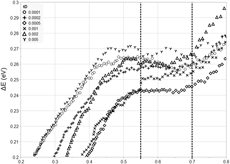Article contents
Peak shape analysis of deep level transient spectra: An alternative to the Arrhenius plot
Published online by Cambridge University Press: 12 March 2019
Abstract

A new deep level transient spectroscopy (DLTS) technique is described, called half-width at variable intensity analysis. This method utilizes the width and normalized intensity of a DLTS signal to determine the activation energy and capture cross section of the trap that generated the signal via a variable, kO. This constant relates the carrier emission rates giving rise to the differential capacitance signal associated with a given trap at two different temperatures: the temperature at which the maximum differential capacitance is detected, and an arbitrary temperature at which some nonzero differential capacitance signal is detected. The extracted activation energy of the detected trap center is used along with the position of the peak maximum to extract the capture cross section of the trap center.
- Type
- Article
- Information
- Copyright
- Copyright © Materials Research Society 2019
References
- 4
- Cited by


